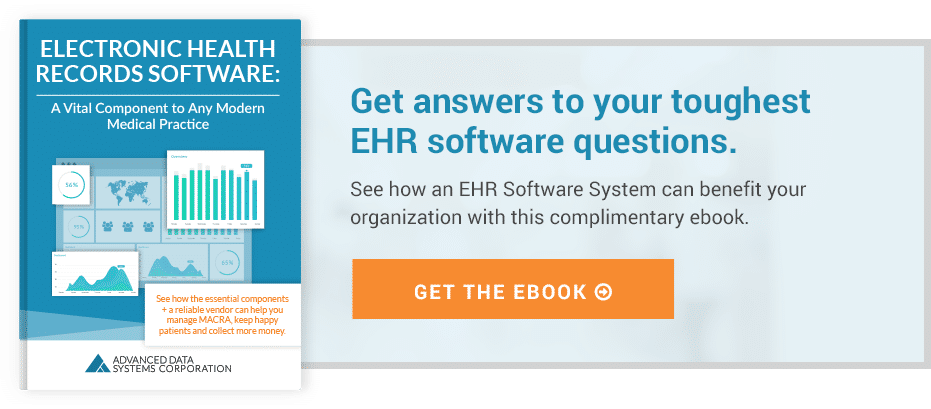The Top 4 Risks and Limitations of EHR Software in 2020
Electronic Health Records (EHRs) are a vital component of most medical practices in today’s digital age. Making the transition from a paper-based system to digital can improve not only the quality of work for your employees but the experience of your patients. However, EHRs are not always perfect.
If you are currently using EHR software, it is likely that you have experienced problems or issues along the way. These problems could include data bottlenecks, a need for additional staff training, and skills mismatches. While there are potential solutions to these problems, EHRs still have inherent risks and limitations, especially moving forward into 2020. These risks and limitations are discussed below, along with recommendations on what should be done.
1. EHRs Are Cumbersome
In an article on EHRs, Computer World notes that technology has become increasingly burdensome for doctors. "Right now, it feels like physicians are a slave to their EHRs,” said Dr. Alain Chaoui, the former president of the Massachusetts Medical Society. “There's a high amount of burnout — emotional burnout, depersonalization, and a low sense of professional accomplishment." This is due to the intricacies of using the system.
At the moment, entering data into an EHR requires a doctor to spend a lot of time doing so. As a result, doctors are putting too much time into this cumbersome process rather than helping more patients. Moreover, approximately 50%–70% of physicians experience burnout symptoms due to EMR-related workloads. This underscores the need to simplify EHRs in 2020 so that they are easier to use moving forward.
2. EHRs Are Generally Not Interoperable
Most of the time, electronic records aren’t shared across EHRs. This means the heavy process of inputting data is usually repeated whenever a patient transfers to a different facility. This has been a longstanding problem, and it might be trickier to solve due to regulations on Medicare and Medicaid reimbursement procedures.
Luckily, there are promising industry initiatives to make the sharing of data between facilities more seamless. Notably, there are the CommonWell Health Alliance and Carequality, which are advocating vendor-neutral interoperability. There is also the Argonaut Project, an HL7 FHIR initiative pushing for the implementation of interoperability standards in the healthcare industry. This implementation will be an ongoing challenge for 2020, and likely beyond. But with EHR offerings built for innovation, sharing patient information electronically will soon be easier and more convenient.
3. EHRs Are at Risk of Cyber Attacks
In August an EHR database fell victim to a ransomware attack. Becker’s Hospital Review reports that the attack locked doctors out of the CHI Health Lakeside Hospital’s EHRs. The breach, in turn, may have exposed patient names and personal details, such as their address and medical history. At the moment the incident seems to have caused no harm, but this case illustrates why enhanced cybersecurity is a challenge for EHRs.
Based on data compiled by the HIPAA Journal in 2018, one of the most popular methods for stealing healthcare information is a phishing scam. These data breaches mean that cybercriminals can use the stolen data and commit fraud. Phishing hackers will often try to contact users in an attempt to acquire financial information. They can then use this information to purchase items illegally or to receive and pay for medical care.
Regardless of how cybercriminals use this stolen data, patients will ultimately be affected, or even burdened by the consequences (e.g. increased credit card bills, the inconvenience of fixing records or locked out of cards). Thus, it is imperative that EHR cybersecurity is improved as soon as possible, and enhanced even more in the future. Especially as technology will continue to evolve in 2020 and become more connected.
4. EHRs Are Prone to Timing Discrepancies
Recently, the ECRI Institute ranked the safety issues healthcare facilities must address for 2020. One of them involves the medication error caused by dose timing discrepancies in EHR systems. “A combination of configuration and usability issues within the electronic health record can contribute to such discrepancies,” explained the report.
These errors, however, can be minimized "if an EHR order-entry system prominently displays the scheduled medication administration time, allows prescribers to easily modify that time, and includes a ‘now’ option for medications that need to be administered as soon as possible.” These deviations need to be addressed in 2020, as they can result in serious errors that could put patients in danger. And a good starting point is the suggestions outlined in the ECRI Institute report.
While these risks and limitations will remain in 2020, Electronic Health Records software providers must continue to adapt and support the changing needs of their users. For more information on EHR software, download our free ebook, “Electronic Health Records Software: A Vital Component to Any Modern Medical Practice.”
Key Takeaways:
-
Using EHRs can be burdensome to doctors, who on average spend around 45 minutes on the computer per patient. This necessitates improvements that will make EHRs simpler and easier to use.
-
EHRs are generally interoperable. Meaning they don’t necessarily facilitate inter-facility exchange of patient data. This should not be the case. Instead, EHRs must allow the seamless but secure sharing of patient information.
-
Cyber attacks are a perennial concern for EHRs. It is, therefore, imperative that cybersecurity is continually enhanced.
-
Timing discrepancies occur in EHRs, and they can lead to serious clinical consequences.
About Aja Jones
Aja Jones is a tech writer with an interest in covering how different industries are evolving in the 21st century. Her aim is to show her readers how technology is shaping modern society, with a particular interest in technological trends within the healthcare industry. When she is not writing she loves to exercise with her husband.


